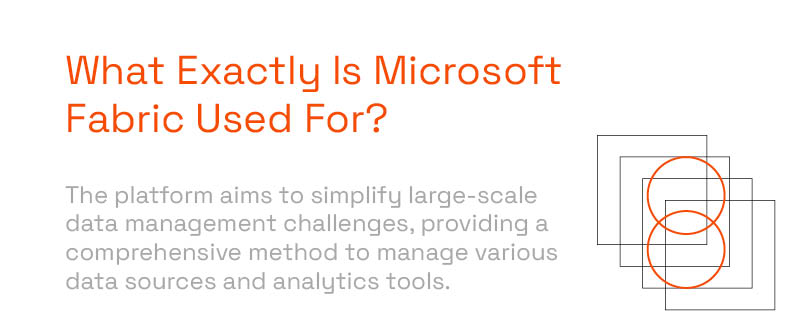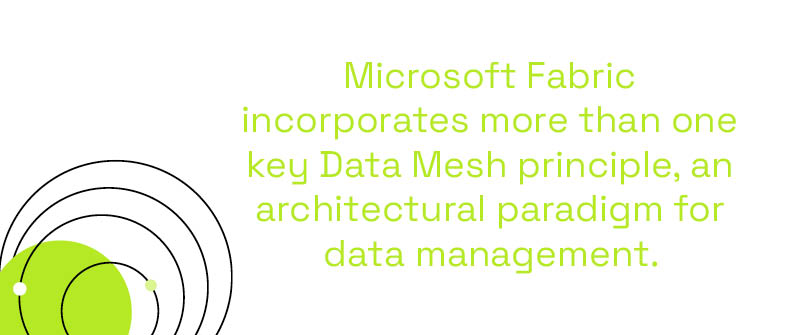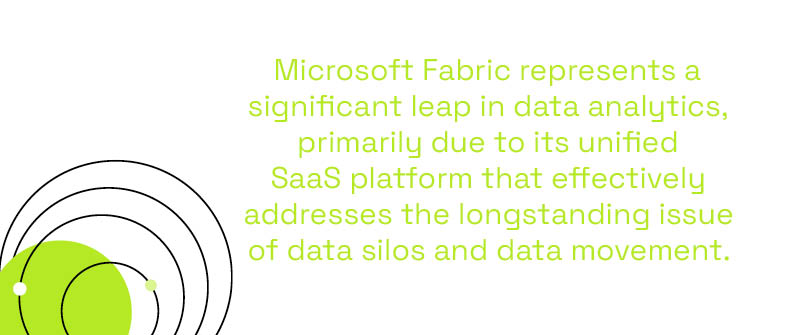
Microsoft Fabric’s development has been significantly influenced by the concept of Data Mesh, a modern approach to data architecture focused on domain-oriented ownership, data as a product, federated computational governance, and self-serve data platforms.
Microsoft Fabric Data Analytics represents a transformative approach to data analytics, integrating a decentralized Data Mesh architecture to enhance organizational data management. By allowing data grouping into distinct business domains, Microsoft Fabric aligns with the principle of domain-oriented data organization.
Each domain in Microsoft Fabric, defined by business units or departments, manages data as per its unique needs, facilitating decentralized governance. This architecture not only simplifies data management but also embeds flexibility and autonomy within each domain, making Microsoft Fabric a pivotal tool in modern data analytics.
This article explores Microsoft Fabric’s capabilities, its relationship with Data Mesh, and its position in the competitive data engineering landscape, providing insights for both expert analysts and those new to tech.
What Is Microsoft Fabric?
Microsoft Fabric is an all-in-one analytics solution for enterprises, extending the capabilities of Azure Synapse Analytics to all analytics workloads. It’s an end-to-end platform that addresses every aspect of an organization’s analytics needs, integrating various Microsoft tools for streamlined workflows. This integration encompasses data integration, engineering, and science, facilitating a new generation of lakehouse infrastructure. Read more in depth about with this review for Microsoft Fabric.
What Exactly Is Microsoft Fabric Used For?
The platform aims to simplify large-scale data management challenges, providing a comprehensive method to manage various data sources and analytics tools. As an end-to-end, cloud-based SaaS solution, it focuses on efficient data integration and processing. Microsoft Fabric is particularly effective in real-time analytics, empowering businesses to make informed decisions swiftly and accurately. Essentially, in the world of data science, Microsoft Fabric offers users a chance to see and analyze all the data they have at once.

Who Are Microsoft Fabric Competitors?
While Microsoft Fabric is a comprehensive solution in its field, it faces competition from platforms like Snowflake and Databricks. These Microsoft Fabric competitors have been making significant inroads into the business intelligence and analytics market, challenging Microsoft Fabric’s position.
Snowflake, known for its cloud-based data warehousing and scalability, and Databricks, with its unified analytics platform, present alternative approaches to data management and analytics. The comparison of Snowflake vs Microsoft Fabric often centers on their approaches to data storage and processing, with each offering unique advantages.
The competition primarily revolves around different methodologies in handling data silos, integration, and leveraging AI for analytics, underscoring the need for businesses to carefully consider their specific data management requirements when choosing a platform.
Is Microsoft Fabric a Data Mesh?
Microsoft Fabric incorporates more than one key Data Mesh principle, an architectural paradigm for data management. It supports domain-oriented ownership by allowing data to be organized and managed within specific business domains, like sales or marketing, within an organization. This approach aligns with Data Mesh’s emphasis on treating data as a product managed by domain experts, enhancing discoverability and usability.
However, Microsoft Fabric does not fully adopt the decentralized nature characteristic of Data Mesh. While it facilitates domain tagging and decentralized governance to an extent, enabling departments to manage their data under their own rules, it retains a more centralized framework. This centralized aspect contrasts with the fully decentralized, domain-driven design of a pure Data Mesh, where complete autonomy and self-service data capabilities are distributed across the organization.
In essence, Microsoft Fabric’s approach is a blend, integrating aspects of Data Mesh while maintaining a certain level of centralized control. It offers a practical implementation of Data Mesh principles, tailored to fit within Microsoft’s broader data and analytics ecosystem, making it a versatile choice for organizations seeking the benefits of both centralized and decentralized data management strategies.

Is Microsoft Fabric a Game Changer?
Microsoft Fabric represents a significant leap in data analytics, primarily due to its unified SaaS platform that effectively addresses the longstanding issue of data silos and data movement. By consolidating various data management tools, including Azure Data Factory, Azure Synapse Analytics, and Power BI, into a single offering, Fabric enables seamless data sharing and integration within organizations. This integration simplifies the analytics process, making it more accessible and efficient.
Moreover, Microsoft Fabric’s integration of AI capabilities, notably through services like Power BI Copilot and Data Activator, further distinguishes it in the market. These AI-driven features not only enhance the platform’s analytical capabilities but also automate and streamline data management processes. The Data Activator service, for instance, actively monitors data changes and initiates corresponding actions, akin to Logic Apps or Power Automate, adding a layer of intelligence and responsiveness to data handling.
In essence, Microsoft Fabric’s integrated approach to data analytics, blending AI-powered automation with a unified data management system, establishes it as a pivotal tool. This approach streamlines the analytics workflow and introduces innovative ways to utilize data for strategic decisions, proving its worth in the constantly advancing realm of business intelligence and analytics

Embrace the Future of Data Management and Data Analytics With Microsoft Fabric and P3 Adaptive’s Expertise
Utilizing data has never been more feasible. Microsoft Fabric represents a pivotal development in data analytics, blending the strengths of various Microsoft tools into a cohesive, AI-powered platform. For businesses looking to leverage the full potential of their data in this era of AI and real-time analytics, Microsoft Fabric offers a solid foundation. Access your data without sacrificing data security or data quality. Partnering with P3 Adaptive can help you explore the benefits of Microsoft Fabric and implement a data strategy that aligns with your business needs. Embrace this opportunity to transform your data analytics journey with the expertise of P3 Adaptive. Get in touch today to get started.
Get in touch with a P3 team member